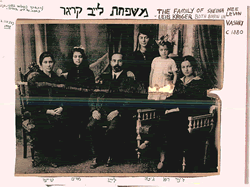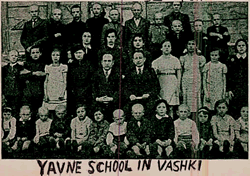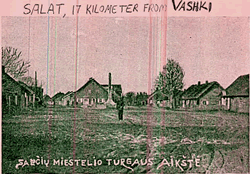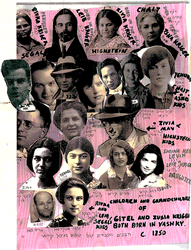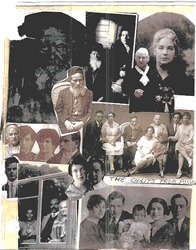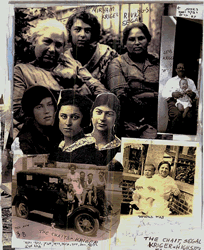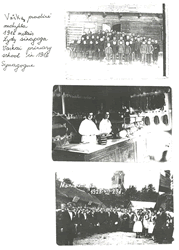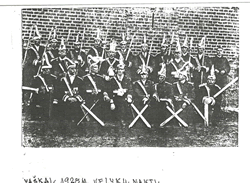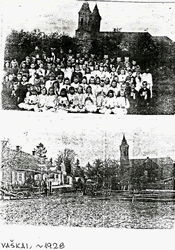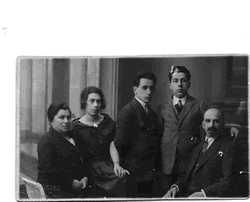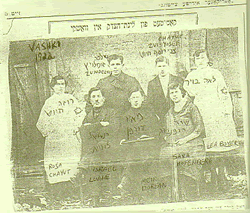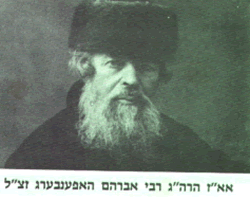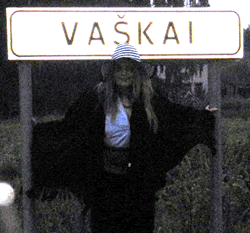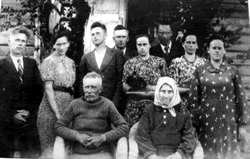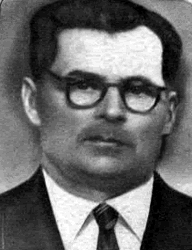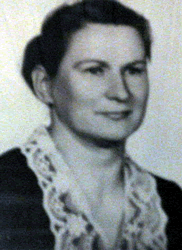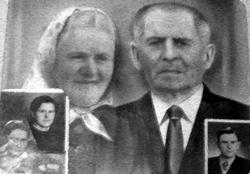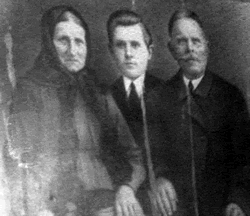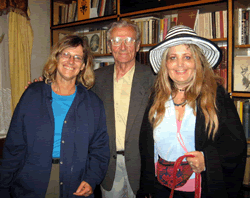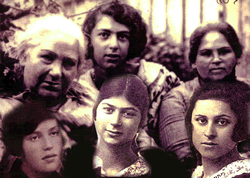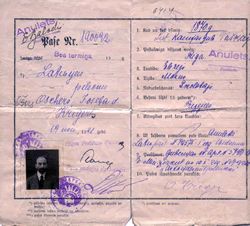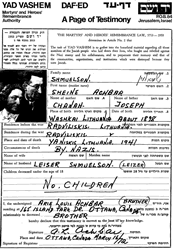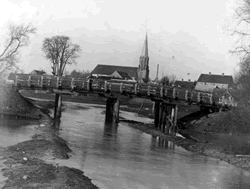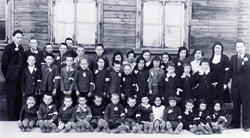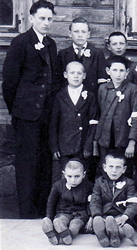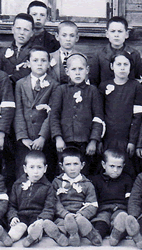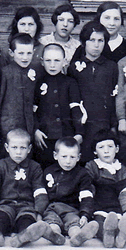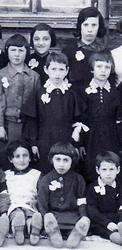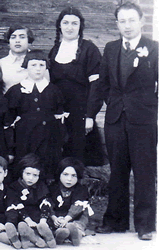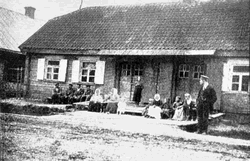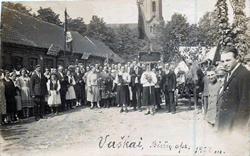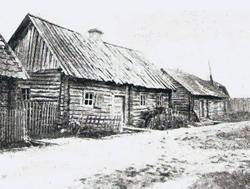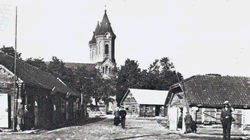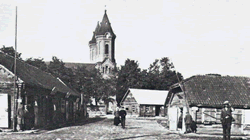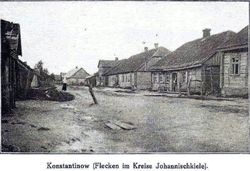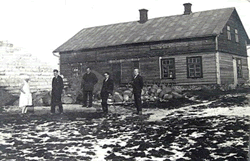Please share your comments or photos or links for posting on our Guestbook Page here: egl.comments@gmail.com
|
Family
Albums
|
||||
Vashki
Vashki sits approximately eighteen kilometers from Pasvalys, Linkova, Zeymel and Salat. It is situated in the northern region of Lithuania, in the vicinity of the Latvian border. Prior to the First World War, there were about 110 Jewish families in Vashki.
General history; the ancestors of the modern Lithuanians were known as Balts. They probably arrived from the southeast at around 2000 BC. By the 12th century the Balt peoples were split into tribal groups, they all practiced "nature religions". The two main ethnic groups in Lithuania were the Samogitians in the west and the Aukstaitiai in the east. In what is now southwest Lithuania and in neighboring parts of Poland were the Yotvingians, also a Balt people, later to be assimilated by the Lithuanians and Poles.
In the mid-13th century Mindaugas, leader of the Aukstaitiai, unified the Lithuanian tribes for a short time under the Catholic mantle. Pagan princes fought back, and then were subjugated by another Christian, Vytenis, who became grand duke in 1290. His brother Gediminas, grand duke from 1316 to 1341, took advantage of the decline of the early Russian state to push Lithuania's borders south and east. It was Gediminas' grandson, Jogaila, who converted to Catholicism and married the crown princess of Poland in 1386, thus forging a 400-year bond between the states. The Aukstaitiai were baptized in 1387 and the Samogitians in 1413, making Lithuania the last European country to accept Christianity. By the end of the 16th century Lithuania had sunk into a junior role in its partnership with Poland, especially after the formal union of the two states at the Treaty of Lublin in 1569. Lithuanian gentry adopted Polish culture and language, Lithuanian peasants became serfs, and the joint state became known as the Rzeczpospolita (Commonwealth).
Poland-Lithuania began to cast interested eyes over Livonia (Latvia) and Estonia on the north, as did Sweden and Russia's Ivan the Terrible. Ivan invaded first in 1558, initiating the 25-year Livonian War. It took Poland-Lithuania and then Sweden many years to expel Ivan and his Russian compatriots. After they managed this in 1592, Catholic Poland-Lithuania and Protestant Sweden settled down to fight each other in the Baltics. The Swedes won, securing Estonia and most of modern Latvia. Meanwhile, conflict continued between Poland-Lithuania and Russia, with the Russians eventually invading the Rzeczpospolita and annexing significant territory. A Prussian revival in the 17th century further weakened the Rzeczpospolita, which was eventually carved up by Russia, Austria and Prussia, with most of Lithuania going to the Russians.
Lithuania was involved in two Polish rebellions against Russian rule in the 19th century, and its peasants weren't freed until 1861. The Russians persecuted Catholics and, from 1864, books could only be published in Lithuanian provided they used the Russian alphabet, and publications in Polish were banned altogether. During WWI Germany occupied Lithuania, but on 11 November 1918, the day Germany surrendered to the Allies, a Lithuanian republican government was set up. Matters were complicated by the re-emergence of an independent Poland. Polish troops took Vilnius in 1919 and retained it, apart from three months in 1920, until 1939. In 1920 Soviet Russia signed a peace treaty with Lithuania recognizing its independence. (Information taken from Lonely Planet)
Jewish LITHUANIA (Lithuanian Lietuva; Pol. Litwa; Rus. Litva; Heb. Lita atyl or htyl; Yid. Lite Atyl), southernmost of Baltic States of N.E. Europe. The region that is sometimes called the pale of settlement was part of the greater Polish kingdom during the 16th to 18th centuries. With the partition of Poland at the close of the 18th century the territories of Lithuania passed to Russia. Subsequently, for over 120 years, Lithuania ceased to exist as a political or administrative unit. It was divided up into six or seven provinces in which the history of the Jews was similar to that of the Jews throughout Russia. Lithuanian Jewry nevertheless retained its specific character, and its influence on Russian Jewry–and on world Jewry in general–extended beyond the boundaries of historic Lithuania.
From the close of the 18th century until World War I this area came under the rule of czarist Russia and included the provinces of Kovno, Vilna, Grodno, and northern Suwalki, which were essentially of Lithuanian-Polish character, and of Vitebsk, Minsk, and Mogilev, which were Belorussian-Russian in character. A distinction is sometimes made between Lithuanian Jews in a restricted sense (from the provinces of Vilna, Kovno, and the northern parts of the provinces of Suwalki and Grodno as the Jews of Vashki were.) and the Belorussian Jews ("province of Russia"). At the close of 19th century, about 1,500,000 Jews lived in this region; they constituted more than one-eighth of the total population. The Jews were mainly concentrated in the towns and villages, where in the main they were in the majority. There were over 300 communities in Lithuania with over 1,000 persons, including 12 large communities each numbering over 20,000 persons: Vilna, Minsk, Bialystok, Vitebsk, Dvinsk (Daugavpils), Brest-Litovsk, Kovno, Grodno, Mogilev, Pinsk, Bobruisk, and Gomel; but even the smaller settlements with only some dozens of Jewish families had a vibrant and full Jewish life. Prior to the First World War most Jews in Vashki (as in other Lithuanian shtetls) were merchants. Many were involved in the garment business. They would mainly export to England. Others were craftsmen.
Both economic and historical factors were responsible for the unique character of Lithuanian Jewry. Lithuania was a poor country, and the mass of its inhabitants, consisting of Lithuanian and Belorussian peasants formed a low social stratum whose national culture was undeveloped. The Jews who had contacts with them as contractors, merchants, shopkeepers, innkeepers, craftsmen, etc. regarded themselves as their superior in every respect. Lithuanian Jewry was relatively less affected by the Chmielnicki massacres that devastated the Jews of Ukraine in 1648—49, and those perpetrated by the Haidamacks during the 18th century. Even when the wave of pogroms swept Russia during the last decades of czarist rule, there were only isolated manifestations of anti-Jewish violence in Lithuania (Gomel, Bialystok). These circumstances gave the Lithuanian Jews a feeling of stability and security, as a result of which they developed no desire to adopt the language and culture of the surrounding peoples
The Jews of Lithuania maintained their own way of life. They spoke a special dialect of Yiddish–Lithuanian Yiddish–that differed from the Yiddish spoken in Poland and Volhynia mainly in the pronunciation of the vowels (and in certain districts in the pronunciation of the Q (shin) as R (sin) or s (samekh). The world outlook and way of life of Lithuanian Jewry were based on the Written Law and the Oral Law. The Shulhan Arukh and its commentaries guided them in their everyday life. Torah learning flourished among wide circles, and love of Torah and esteem for its study was widespread among the masses of Jews. The Jews who lived in the region bordering Lithuania, the "Poles" in the west and the "Volhynians in the south, associated specific characteristics with the Lithuanian Jews: a certain emotional dryness, the superiority of the intellect over emotion, mental alertness, sharp-wittedness, and pungency. Their piety was also questioned (hence the popular derogatory appellation for the Lithuanian Jews, "tseylem-kop"). It was also a feature of Lithuanian Jewry that Hasidism did not strike roots in northern Lithuania; while in the provinces of Byelorussia it assumed a different nature and content–the Habad trend–from the original Hasidism of Ukraine and Poland. Lithuanian Jews were considered the "prototype" of the Mitnaggedim.
Prior to the First World War most Jews in Vashki were merchants. Many were involved in the garment business. They would mainly export to England. Others were craftsmen.
Lithuanian Jewry was particularly oppressed during World War I. The attitude of the Russian military authorities toward the Jews was one of suspicion and hostility; rumors were spread that they were traitors, and the army therefore perpetrated pogroms against them. In the spring of 1915 expulsions of Jews from the provinces of Suwalki, Kovno (Kaunas), Courland, and Grodno began.My grandmother Lola nee Chait, who lived in a shtetl near Vashki, told me that the Jews were given less then twenty four hours notice that they have to appear in the railroad station with their entire family ready to be taken to an undisclosed location. They gathered their belongings but could not find a horse and carriage to take them- they were all taken by other Jews. They had no choise but to walk a long and laborious road to the station and when they got there they were put in very crowded fright train. They traveled for many days only stopping periodically to let the human cargo relieve themselves in the fields. Finally their particular train arrived in Crimea and all the children were taken to the homes of various Jewish families of the local community (Lola was 9 years old at that time) the family eventually had a home and they returned to their shtetl about four years later.
During the fall of 1915, the German army occupied northern and western Lithuania. The population that was not expelled suffered from lack of food and unemployment. Limited aid arrived from the Jews of Germany and the United States and a ramified Jewish assistance organization was set up. A network of Hebrew and Yiddish schools, including secondary schools, was established. After the end of World War I, a considerable number of refugees returned to their former places of residence. Lithuanian Jewry was henceforward divided among three states: independent Lithuania, Belorussian S.S.R., and Poland.
About a year before the end of World War I, on Sept. 18—23, 1917, precisely two years after the capture of Vilna by the Germans, the Lithuanians were given permission by the German occupation force to hold a congress in Vilna to consider the future political fate of Lithuania. The congress put forward the demand for an independent Lithuanian state within its ethnographic boundaries with Vilna as the capital. The Vilna congress also elected a national council, Lietuvos Taryba, which on Feb. 16, 1918, proclaimed Lithuania an independent state. The Germans maintained their occupation of Lithuania until the end of 1918. During the early years of Lithuanian national independence the Jews had a predominant part in the export-import trade. However, shortly before World War II Jewish participation in the export trade amounted to only 20%, and in the import trade to 40%. In 1923 there were nearly 14,000 Jewish shops and 2,160 non-Jewish shops; in 1936 the respective numbers were approximately 12,000 and 10,200. The majority of Jewish shops were small-scale establishments. Jewish traders were unable to compete with the Lithuanian cooperatives, which enjoyed great privileges especially in respect of taxation. They increased rapidly and, between 1919 and 1925, the number of such competitive enterprises ranged against Jewish trade doubled in number.
About one-third of the Jews earned their livelihood in crafts. There were Jews also in the professions, but their numbers continually decreased, and their places were taken by Lithuanians. At the beginning of 1931 there were 88 Jewish cooperative people's banks having more than 20,000 members and functioning in conjunction with an association of Jewish people's banks. The Jewish people's banks owned a portion of the working capital of the central bank for the support of Jewish cooperatives.
Both open and unofficial measures aiming at ousting Jews from their economic positions led many Jews to emigrate. Between 1928 and 1939, 13,898 Jews emigrated from Lithuania, of whom 4,860 (35%) went to South Africa; 3,541 (25.5%) to Palestine; 2,548 (18.3%) to Latin America; 1,499 (10.8%) to the United States; 648 (4.6%) to Canada; and 602 (5.8%) elsewhere. It is estimated that between 1923 and 1927 at least 6,000 to 7,000 Jews emigrated from Lithuania, and between 1919 and 1941, 9,241 Lithuanian Jews emigrated to Palestine (3.07% of all those who settled there in that period
Some information was taken from; http://www.heritagefilms.com/LITHUANIA.html#Character and Influence on the Diaspora
After the war and the Russian revolution less then half of the families returned to Vashki.
During the later years of Lithuania independence (1922- 1940) the garment business was in bad shape due to strong competition from soviet Russia. In addition, the Lithuanian government established cooperatives that competed with the independent Jewish craftsmen. Therefore many Jews in Vashki became poor and saw immigration as the only solution for their financial difficulties. They left for South Africa and the U.S.A.
The Jewish bank in Vashki had 78 members in 1929.
The Jewish school in Vashki, Yavne, had 38 children attending. They also had a "Beit Midrash". Some of the Vashki rabbis; Rabbi Yehuda Chariff, Rabbi Avraham Hofenberg who was a rabbi for 48 years and died in 1929. Many of his students became rabbis in Israel and in the U.S.A.
His son in law, Eliezer Levin, wrote a book and was a rabbi in Detroit.
The last rabbi was Yakov Zvi Yankilev. He was very dedicated to his students. In 1940 when the soviets took over the area and did not allow Jewish studies he collected the students in his home and secretly continued teaching them religious studies in spite of the fact that if he was caught by the authorities he would have been sent to Siberia
In 1939 only about forty five Jewish families lived in Vashki.
.
German Occupation of Lithuania, 1941—44
The Germans occupied the entire country within one week, so that only a handful of Jews managed to escape into the Soviet interior. Lithuania, called Generalbezirk Litauen, was included in the administrative province of the Reichs Kommissariat Ostland which also included the other Baltic republics, Estonia, Latvia, and also Belorussia. Hinrich Lohse was appointed Reich Commissar of Ostland, with headquarters in Riga. The Generalbezirk consisted of three districts: the xiauliai (Shavli) district, the Kaunas (Kovno) district, and the Vilna district. Adrian von Renteln, the commissioner general for Lithuania, had his seat in Kaunas (called Kauen by the Nazis). The Germans also established a local administration, composed of pro-Hitler elements. Lithuanian "councillors general" (a sort of minister) were appointed, headed by Petras Kubiliunas, a former general in the Lithuanian army.
On Aug. 13, 1941, Lohse issued secret "provisional regulations" to the general commissioners of Ostland specifying how to deal with Jews pending the application of the "final solution" of the "Jewish question" in Ostland. These orders applied to all the Jews in Ostland–former citizens of Germany, Czechoslovakia, Poland, the Baltic states, and other parts of the Soviet Union. There were special instructions for the treatment of foreign Jews and persons of mixed parentage. The commissioners general were required to register all the Jews under their regional jurisdiction and to issue compulsory orders to them to wear two yellow badges (one on the chest and one on the back). Jews were prohibited from moving from their house or place of residence without permission from the district or city commisioner; using the sidewalks; using public transportation; residing in spas; visiting parks and playgrounds, theaters, cinemas, libraries, museums, or schools; owning cars or radios. Ritual slaughter was also prohibited. Jewish doctors were permitted to treat only Jewish patients; pharmacies owned by Jews were turned over to Aryan pharmacists; Jews were not permitted to function as veterinarians, lawyers, notaries, bank officials, or commercial agents, nor could they deal in real estate or freight forwarding. All Jewish property was confiscated. Persons holding Jewish property had to report to the German administration, which dealt with its confiscation. Only the bare necessities of furniture, clothing, and linen were left in Jewish possession, and an allowance of no more than 20 pfennig (about $0.05) per day per person was permitted to the Jews. Finally, the regulations provided for the concentration of the Jews in ghettos, where food and other necessities were supplied to them only insofar as no shortage resulted for supplying the general population. Inside the ghettos, the Jews were permitted "autonomy" in their affairs, subject to the supervision of the regional commissioner, and had their own Ordnungsdienst ("police force"). The ghettos were sealed off from the outside world and put under the guard of auxiliary police recruited from among the local population. Able-bodied Jews were put on forced labor, inside or outside the ghetto. Private persons or enterprises utilizing Jews in forced labor paid the regional commissioner directly. The commissars general were authorized to issue orders based on Jewish population in VASKAI (VASHKI) was 267 people. Information taken from; 'Black Book of Localities whose Jewish population was exterminated by the Nazis.' Yad Vashem, 1965.
Einsatzgruppen
The Einsatzgruppen (Action Units) played a major role in the destruction of the Jews in the occupied eastern territories, including Lithuania. Einsatzgruppe A was attached to the Northern German army and operated in the Baltic States and Leningrad area. Details of the murder of the Jews in Lithuania are contained in some of the 195 Einsatzgruppen reports regularly submitted to the R.S.H.A. (Reichssicherheitshauptamt) in Berlin.
.
"Devastation of the Jews from Posvol and nearby shtetlach (Yanishkel, Vashki, Linkuva, Salat, Vabolnik)"
by B. Reinus in Lite Translated by Dr. Sonia Kovitz
Posvol was a terrible graveyard not only for the local Jews but for all their fellow children of Israel in the surrounding shtetlach. (The following is based on information supplied by Taibe Aizikovitch-Gutman and Moshe Gutman, both from Posvol, now living in Philadelphia.)
As yet isolated arrests (Chane Akhbar, Meir Binder, Yankl Milman) took place on the morning of June 27, 1941 when the Germans marched into Posvol. A week later (July 4) the arrests of hundreds of shtetl Jews began. Some of the captured Jews were imprisoned in jail and some in a shop for selling rye that belonged to Yoel Farber. One night two policemen (Lithuanian partisans) and two Germans came and demanded that young Jewish girls be handed over to them. By means of a large bribe this calamity for Jewish children was narrowly averted.
A few days later the arrested Jews were taken in two transports to the jail in Shavl. Some of the women were freed and of these the majority returned to Posvol, where they were later murdered. Of the women who remained in Shavl a small number were ultimately saved.
Around July 15 the [people in the] Posvol ghetto were shot. The area of the ghetto included half of Birzer Street up to Leib Milner (Balishker's) house and all of Polevener Street.
One day the virsheitis [town-elder] Maldutis came to the ghetto and announced that anyone giving gold and money would be sent to a camp from Popovesse to work. The few who believed in this speech had their money and jewelry taken by the bandits and then were brought back to the ghetto.
For the short time that the Posvol ghetto existed, people ate food distributed by a ghetto-cooperative managed by the local rabbi, Rav Yitzhok Agulnik.
A few weeks before the liquidation of the Posvol ghetto, Jews from various surrounding shtetlach were sent there. Among the persons from Yonishkel were the Todes sisters, Dr. Lichtnshtein, the Asch family (the husband was shot in Yanishkel), Moshe-Aharon Zlot, Reuven Zlot's daughter-in-law, and others.
The Yonishkelers reported the khurbn [destruction] in Linkuva, which was among the first of the kehillot [Jewish communities] to be slaughtered. Immediately in the first days of the German occupation, the Linkuva partisans with the police chief Petreitis in charge locked up Jewish males in a stable. Some of them were shot and the rest were transported to Shavl. Also the wives and children of the men who were shot were murdered, later in a camp behind Linkuva.
One of the Linkuva partisan-leaders, Pavilis Ratshis, was later promoted to the office of Plenipotientiary for Jewish Affairs in the Shavl ghetto. He caused grave difficulties for several Linkuva Jews who were in the Shavl ghetto, and denounced Barkum, Girsh and Blumenson as Communists. They were temporarily saved by this calumny but later they were murdered.
Among the murdered from Pumpian were: Chana Kramer (The Innkeeper) and her family, Ester Milner, the Segal family and others.
Among the persons transported together from Vashki were: the family of Shmuel Katz, Hirsh Katz, Dorfan Trapide, Motl Galin, Tose (Dovid Balsher's aged mother-in-law), Chaim-Shloime (the Vashki shammas ) and others.
From the arrested Jews of Salat the names of the following Jews are remembered: Avraham Chait, Chaim Shvidgal, Motl Lurie, Ida Chait, B. Volpe, Musnson, Novishets all with their families.
Among those brought from Vabolnik were: Chaim Kruk, Ben-Tsion Davimos, Abba Stolier, the Levin brothers all with their families and other Jews.
A bizarre occurrence took place among the Jews from Vabolnik certainly not for the first time in Lita: over 40 Jews from Vabolnik converted to Christianity in hopes of saving themselves in this manner from the hands of the German-Lithuanian butchers. The Jews who decided on this terrible step in order to save their families deliberated long and painfully. They tried to find a protector among Rambam (Maimonides) and other brilliant scholars, and tried to reason with each other that they were only going to change their faith for appearances' sake until this passes and then they would become Jews again. They rummaged around in the history of the marranos and asked each other: aren't we marranos no less than our fellow Jews of former times in Spain? And with a bitter spirit they set out on the bitter path of apparent conversion.
Here it should be noted that the priest from Vabolnik who administered baptism to these Jews knew very well that the conversion was only temporary. He himself emphasized to the Jews that he wanted not to capture any souls but was only counseling them for conversion in order thus to save them from death.
The converted Jews were taken to Posvol along with the other Jews from Vabolnik. For a period of time they were held separately and thought that their conversion would perhaps save their lives. At the last moment, however, they were driven out with the other Jews to the slaughter.
On August 27 the Jews from the ghetto were ordered to assemble in the bes medresh (which was located outside the boundaries of the ghetto). A sham order was given that they were being taken to work and had to bring all their things along with them. Later the men were separated from the women and children, who were taken away to the Lithuanian school on Vilner Street.
On that same day the martyrs were taken into a grove of trees four kilometers from Posvol. The Lithuanian partisans carried out the slaughter under the direction of the Germans, who stood nearby. At the last moment the following managed to escape death: Anna Maras (now in Vilna), Tana Balan and Tsippa Davidovitch (both now in Posvol) and both the Todes sisters from Yanishkel (now in New York).
Here it is worth mentioning an interesting fact on whether or not the Posvol Lithuanian city government officially took part in exterminating the Jews of the Posvol ghetto. They debated and discussed the matter exactly as if it concerned paving a little bit of street with cobblestones or handling dog license fees and they decided, yes, murder them all!
The names of the following Lithuanian hooligans who especially excelled in violent deeds should be recorded for future generations and also perhaps for revenge. Petras Bieluskas and Veitkus (a shoemaker) came to loot the home of Leib Aizykovitch and killed his wife Beila Gitta. Strazdas Yuazas (a tailor) and Metskus beat people to death on the transports to Shavl. Ignats Ogentas, Gudas Leonas, Antanas Birkuskas, Yanas Vilimas, Visatskis and others inflicted atrocious tortures on Jews. They and still others killed approximately 1600 Jews from the beautiful communities of Posvol and approximately 300 dear Jews (many of them shot on the spot) from the surrounding shtetlach mentioned above.
Among the small number of Lithuanians in the region who risked their life and saved Jews is Baniolis. He hid three Jewish girls for three years in a stable and provided them with food. His name should be recited with honor.
